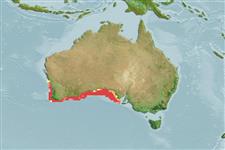Elasmobranchii (sharks and rays) >
Rajiformes (Skates and rays) >
Arhynchobatidae (Softnose skates)
Etymology: Irolita: From Irolita, a princess in love with prince Parcinus. The beauty of the princess was worthly the world´s admiration. Mythology.
Environment: milieu / climate zone / depth range / distribution range
Ecology
Marine; demersal; depth range 50 - 200 m (Ref. 6871). Temperate; 29°S - 36°S, 113°E - 136°E (Ref. 114953)
Eastern Indian Ocean: south-western Australia.
Length at first maturity / Size / Weight / Age
Maturity: Lm ?, range 46 - ? cm
Max length : 52.0 cm TL male/unsexed; (Ref. 6871)
Occur over soft bottoms of the continental shelf (Ref. 7300, 75154). Oviparous. Distinct pairing with embrace. Young may tend to follow large objects, such as their mother (Ref. 205). Eggs are oblong capsules with stiff pointed horns at the corners deposited in sandy or muddy flats (Ref. 205). Egg capsules are 5.1-7.6 cm long and 3.2-3.8 cm wide (Ref. 41308). Males reaches maturity at ca. 46 cm TL. Occassionally caught as bycatch and typically discarded (Ref. 114953).
Life cycle and mating behavior
Maturity | Reproduction | Spawning | Eggs | Fecundity | Larvae
Oviparous, paired eggs are laid. Embryos feed solely on yolk (Ref. 50449). Distinct pairing with embrace. Young may tend to follow large objects, such as their mother (Ref. 205).
McEachran, J.D. and K.A. Dunn, 1998. Phylogenetic analysis of skates, a morphologically conservative clade of elasmobranchs (Chondrichthyes: Rajidae). Copeia 1998(2):271-290. (Ref. 27314)
IUCN Red List Status (Ref. 130435)
Threat to humans
Harmless
Human uses
More information
Age/Size
Growth
Length-weight
Length-length
Length-frequencies
Morphometrics
Morphology
Larvae
Larval dynamics
Recruitment
Abundance
BRUVS
ReferencesAquacultureAquaculture profileStrainsGeneticsElectrophoresesHeritabilityDiseasesProcessingNutrientsMass conversion
Tools
Special reports
Download XML
Internet sources
Estimates based on models
Preferred temperature (Ref.
123201): 15 - 18.5, mean 16.6 °C (based on 27 cells).
Phylogenetic diversity index (Ref.
82804): PD
50 = 0.7500 [Uniqueness, from 0.5 = low to 2.0 = high].
Bayesian length-weight: a=0.00550 (0.00273 - 0.01106), b=3.10 (2.93 - 3.27), in cm total length, based on LWR estimates for this (Sub)family-body shape (Ref.
93245).
Trophic level (Ref.
69278): 3.8 ±0.7 se; based on size and trophs of closest relatives
Resilience (Ref.
120179): Low, minimum population doubling time 4.5 - 14 years (Fec assumed to be <100).
Fishing Vulnerability (Ref.
59153): Moderate vulnerability (41 of 100).
